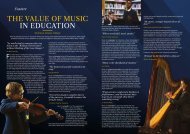Create successful ePaper yourself
Turn your PDF publications into a flip-book with our unique Google optimized e-Paper software.
89<br />
Hidden Voices<br />
The Haka: History Hidden in<br />
Plain Sight<br />
The vigorous thigh slapping, eye bulging, and blood<br />
curling roaring of the haka is perhaps most synonymous<br />
with the New Zealand rugby team, nicknamed<br />
the All Blacks. Performed before the kick-off<br />
of every match the haka has become symbolic of<br />
New Zealand rugby, many seeing it as a metaphor<br />
of their aggressive, high tempo and free flowing<br />
style of rugby, however, the true meaning and<br />
purpose of the haka is hidden in plain sight. The<br />
haka is steeped in Maori mythology and history. A<br />
tribe originating from Tahiti, the Maori migrated<br />
to modern day New Zealand in the 14 th Century in<br />
an event that is described as the arrival of a great<br />
fleet who rowed and sailed across the Pacific Ocean<br />
in small wooden boats. Therefore, the origins of<br />
the Haka actually derive first from French Polynesia<br />
and not New Zealand. Nevertheless, the Haka<br />
has become a staple in New Zealand’s culture often<br />
being performed at life events such as weddings,<br />
funerals and birthdays, as well as in national events.<br />
However, the true meaning and purpose of the<br />
Haka is not a sort of theatrical performance. First<br />
and foremost the Haka was performed as an aggressive<br />
war dance to intimidate foe and as a way to<br />
prepare a tribe for battle. When two groups would<br />
meet on the battlefield, they would both perform<br />
their own version of the Haka, it was a formality<br />
that was steeped in tradition. The obvious goal of<br />
this is intimidation of the enemy tribe before battle,<br />
however, it also a ritual that holds its roots in Maori<br />
legend and mythology. The sun god Tama-nui-te-ra<br />
and one of his wives, Hine-raumati, who embodies<br />
the essence of summer, had a son named Tane-rore.<br />
The Maori believed that the shimmering heat haze,<br />
the kind you can<br />
often see over the<br />
grass on a hot day<br />
or coming out the<br />
back of planes at the<br />
airport, was Tanerore<br />
dancing for his<br />
mother. As a result,<br />
the haka emulated<br />
this light, rapid<br />
movement, with the<br />
typical trembling<br />
hands representing<br />
Above: a painting from c.1845 depicting the Haka<br />
Tane-rore’s dance. Therefore, the haka also served<br />
as a ritual to the Maori gods and performed on the<br />
battlefield or during life events it acted almost like<br />
a prayer or request for a blessing. Thus, it is unsurprising<br />
that the haka is still performed during life<br />
events to this day just like how other religions and<br />
cultures around the world have their own ways of<br />
praying or seeking a blessing.<br />
When it comes to the performance of the haka before<br />
All Blacks games, it is a fairly recent addition.<br />
The style of haka performed by the All Blacks is<br />
the ‘Ka Mate’ which was first composed in 1820 by<br />
the Maori chief Te Rauparaha. The All Blacks began<br />
performing the Ka Mate Haka in the early 20 th<br />
Century; however, this was often only done at away<br />
games. It was often performed poorly, half-heartedly<br />
and often as a spectacle rather than something of<br />
substance with true umph and meaning. It was only<br />
when the New Zealand rugby legend, Wayne ‘Buck’<br />
Shelford, took the reigns of the All Blacks that the<br />
haka was taken seriously. Shelford forced the whole<br />
team to learn it and to understand the true meaning<br />
behind the haka in order to instil the passion<br />
required to execute it properly. Nowadays the haka<br />
is performed with passion and intensity. As a result,<br />
the vigorous thigh slapping, eye bulging, and blood<br />
curling roaring of the haka has become an intimidating<br />
pre-match formality for any team coming<br />
up again. Perhaps more importantly, the haka has<br />
become a symbol of Maori culture and synonymous<br />
with New Zealand.<br />
Alex Wilkinson U6LAB


















